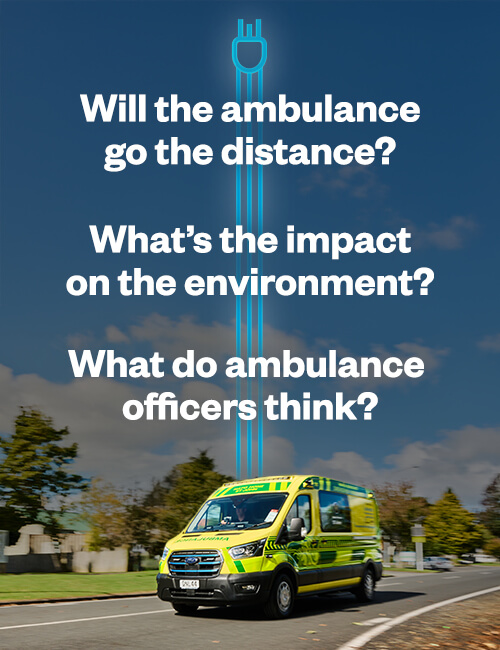As part of this commitment, we’re trialling Australasia’s first electric emergency ambulance to see if an EV ambulance could be a viable solution to help reduce our emissions and integrate sustainable practices into the care we provide. Supported by our long-standing Major Sponsor, ASB, this groundbreaking trial is based in Hamilton in the mighty Waikato.
Real-world testing for a sustainable future
The trial involves real-world testing by our ambulance officers. Insights will help us understand if and how an electric vehicle (EV) emergency ambulance service could operate in Aotearoa New Zealand. Some of the questions we are asking are:
- Will our ambulance officers feel confident about the vehicle's reliability and technology in an emergency?
- Can the vehicle’s battery and power endure when we put it through its paces across typical distances and terrain our ambulance officers encounter in a shift?
- What benefits from an environmental perspective and cost savings will we see from an EV emergency ambulance versus a traditional emergency ambulance?
Currently, we are seeing positive results from the above questions
Looking at the distance the EV ambulance travels, and range anxiety associated with EV vehicles, we are seeing impressive results. The EV emergency ambulance is finishing a typical 12-hour shift in the Hamilton area with enough battery remaining, to be able to go directly into a night shift.
The EV ambulance has travelled close to 8000km since launch. As our electricity comes from Meridian (100% renewable) the emissions associated with charging is 0kg CO2e. This means when compared to our standard ambulances we have prevented an estimated 2400kg CO2e just from this one vehicle, which is great for the environment.
Looking at running costs, we are seeing on average, the EV emergency ambulance costing half of what is costs to run a standard ambulance.
What our people think of the EV emergency ambulance is important to us. It’s their office for the duration of their shift, so we want to make sure they are confident and have trust in it. We have seen staff easily adapt to the range-limited vehicle, with the most significant changes in mindset coming from the different internal layouts compared to a standard ambulance.

Thank you ASB
A heartfelt thank-you to ASB, our long-standing Major Sponsor, for supporting this initiative and helping us lead the way in sustainability for Aotearoa New Zealand.
See the launch of the new EV emergency ambulance and hear from those involved
Watch the video below to hear from our ambulance officers and others involved in this pioneering project, captured during the launch of the EV emergency ambulance in Ngāruawāhia.
We’re excited to share this journey with Kiwis and invite you to follow along as we learn, adapt, and innovate.
Questions?
If you have any questions about this trial, check out some helpful FAQs below. For more details, you can also read the media release from the launch.
All your questions about our EV ambulance answered here